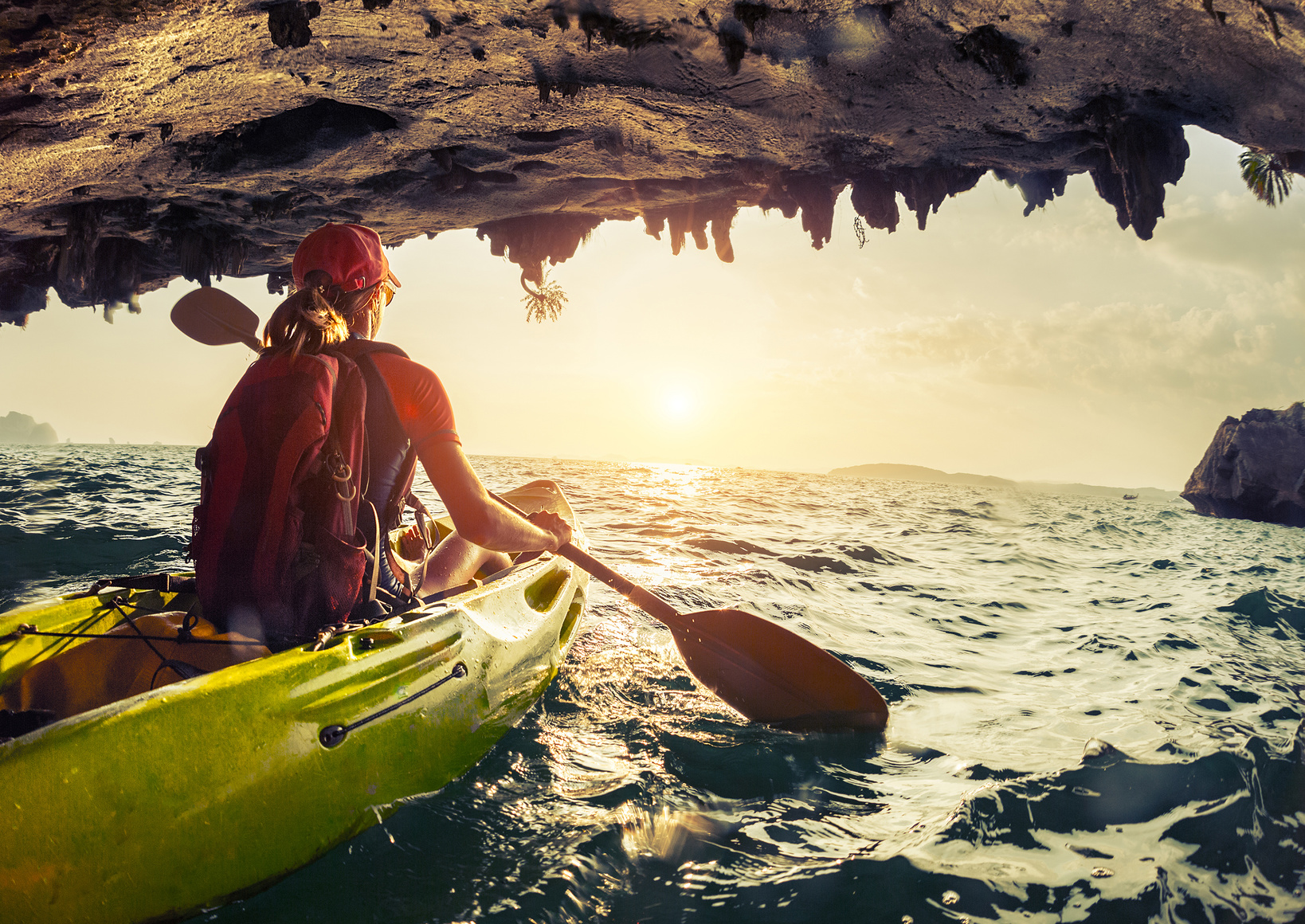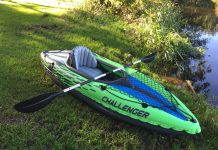
I know how difficult it can be to learn a new sport or outdoor adventure activity. There are groups to join, courses to take, gear to buy, skills to master… it starts to feel exhausting extremely quickly! That’s why we’ve composed this article to help you learn how to start sea kayaking.
While we may not cover every possible piece of information here, you should find this article to be a an excellent primer on sea kayaking for beginners. We’re going to talk in brief about the skills, gear, and tools you will need on your journey… without overloading you.
The Gear You’ll Need
You’ll want to start off with proper gear, otherwise, you’ll find sea kayaking to become dangerous and uncomfortable quickly. Here is a rundown of the essential gear for sea kayaking:
Sea Kayak
Sea kayaks are longer than the average recreational kayak. Often measuring 17’+ in length, these narrow boats sometimes have rudders to aid with tracking and steering. They also come equipped with plenty of watertight storage for touring.
Sea kayaks vary tremendously in quality, and you may wish to rent or borrow while getting started. Good sea kayaks can be very expensive, and it would be most inconvenient to find yourself falling out of love with the sport just after purchasing an expensive new kayak!
There are a few technical details you’ll need to consider when choosing a sea kayak. If you’re completely unsure about what to look for, strike up a conversation with of the sales reps at your local paddle shop and explain the kind of trips you plan on going on. They’ll be happy to walk you through sea kayak features and suggest models that are suitable for the kind of paddling you intend on doing.
Pro Tip: Look for a spray skirt to go with that new kayak when you buy so that it fits properly.
Paddle
Selecting a kayak paddle can be tricky for the novice. Paddles are, surprisingly, quite different when it comes to blade type, length, material, etc.
For sea kayaking, you’ll want to invest in a high-end lightweight paddle purpose-built for the conditions of the ocean. Don’t make the mistake of picking up a cheap recreational paddle!
Read about all the details of choosing a sea kayak paddle here.
Remember that your paddle determines how much energy you will expend to move yourself forward. For sea kayakers, paddling all day for many days in a row is quite common and necessary for touring. Be prepared to spend top dollar for a lightweight paddle that won’t leave you exhausted after a day of paddling with it.
PFD
Once called life vests or life jackets, personal flotation devices, as they’re now known, come in many sizes and shapes.
Those cheap PFD’s from the pool store aren’t going to cut it for sea kayaking. Look for a purpose-made PFD with plenty of room around the arms for freedom of movement.
For some great information to get you started, read through the REI PFD buyer’s guide.
Dry Bags
One of the most overlooked pieces of equipment, a dry bag is a waterproof sack which is meant to keep your clothing and equipment dry and safe. Because they trap air, these bags have the added benefit of flotation! Convenient.
Remember to always fold the top at least three times before buckling the closure. Expel as much unnecessary air as possible before folding and buckling the top of your dry sack. Store inside your waterproof bulkhead for added protection on those moisture sensitive pieces of gear (like your sleeping bag).
Taking a Lesson
If you’re going to learn to sea kayak, we recommend taking a lesson. Sea kayaking may expose you to adverse weather and water conditions where life and death can depend upon true mastery of skills.
DO NOT attempt to sea kayak in open water with any chance of adverse sea or weather conditions until you’ve been trained.
What should you learn in a sea kayaking lesson?
- Master the wet release
- Become familiar with basic and advanced paddling strokes
- Learn the details of your gear and how to use it
- Fully understand your PFD and how it’s designed to be used properly
- Learn how to navigate rough water and how to read incoming weather
- Learn to roll a sea kayak safely

Sea kayaking courses will teach you how to do this
While a good sea kayaking lesson is great, the ideal solution is to enroll yourself in a multi-day course.
Learn how to pack your kayak, make and break camp, and how to paddle for a few days at a time while handling the adversity of being out in the wild. It’s a lot to take on at once and traveling with partners and a trained guide is the most intelligent way to learn at first.
Possibly the leader in expedition training the world over is NOLS, the National Outdoor Leadership School. I trained with them for several years, and the professionalism and training can’t be beaten. Consider looking through the NOLS offerings of sea kayaking courses for world class training!
Join the Community
Look for ways to get involved and improve your skills and knowledge by joining up! No, not the military. Search for local kayaking groups and join their scheduled events to meet like-minded people. Use social media, such as Facebook, and simple Google searches to start narrowing down potential groups which may welcome you to join them!
Additionally, it may be helpful to immerse yourself in the industry by reading or subscribing to publications such as Sea Kayaker Magazine. While there are plenty of kayaking and paddling publications and websites, we advise limiting your exposure to only one or two. Too much information can become overwhelming and confusing. Don’t go overboard.
Dangers of Sea Kayaking
Sea kayaking is an adventure sport and, therefore, includes inherent dangers. Inherent dangers are those which cannot be separated from the activity its self. That is to say – if you choose to sea kayak, you must accept these dangers:
- Weather – Weather can cause temperature dangers such as hypothermia. Severe storms bring lightning and high winds which are not only dangerous on water but also on land.
- Water – Water dangers are many when sea kayaking. Not least of all drowning, cold shock, or violent waves.
- Camping – Camping comes with inherent dangers in the backcountry. When touring, you may encounter wild animals, widow-makers, and natural hazards while at camp.
- Traumatic Injury – When paddling in shallow water or near rocks, there exists the potential for traumatic injury. Helmets are advised.
While sea kayaking may include many inherent dangers, taking the proper steps to mitigate them is simple with good training. Always stay aware and prepared on the water. Kayaking with a friend or a more experienced peer is always necessary.
Remember that with the proper tools and training, sea kayaking need not be unnecessarily dangerous. Like many high-risk activities, learning and mastering your sport will make it much safer to participate in.
Conclusion
We haven’t covered all the skills and knowledge necessary for sea kayaking by any means. However, you’ll find more helpful kayaking articles on our site to round off your education.
Get started sea kayaking by taking a group lesson where you can meet new friends and acquire new skills. Join a local group and continue to improve your skills on short trips with trained peers.
As you become a seasoned sea kayaking veteran, you’ll be able to take on longer trips and explore more adventurous locations.

Ready to explore gorgeous beaches, hidden bays, and secret coves?
As sea kayaking is most often a touring sport (meaning multiple days), it would be prudent to learn good lightweight camping skills. Consider taking a course or practicing your camping and backpacking to round out your skillset. Becoming a competent and successful backcountry traveler means mastering many different classes of skills.
If you’ve got any other tips and advice on sea kayaking for beginners, please share them in the comments below.
As an Amazon Associate, we earn from qualifying purchases. This is without any additional costs for the buyer but does support us in maintaining our website.



